Earliest meeting: 1680
Final meeting: Wednesday 13th July 1898
The Merseyside market town of Newton-le-Willows, formerly Newton-in-Makerfield, was historically part of Lancashire and is located 4 miles east of St Helens and a stone’s throw from Haydock Park racecourse. John Cheny registered a meeting in the town in 1732, while the first time racing in the town was included in Baily’s Racing Register was for the meeting held on Thursday 6th May 1751 on Golborne Heath when Mr Frank’s gelding got the better of Leigh Masters’s bay gelding. Less than a month later a 2 day meeting was staged from Saturday 5th to Monday 7th June 1751 when the Newton Hunt Cup was won by Sweet William, owned by Robert Parker; the First Subscription Purse by Tawney, and the Second Subscription Purse by Figg, owned by Mr Hunt.
However, there is evidence that racing took place at Newton as early as 1680, and it is extremely likely that racing had been staged prior to this date. In 1680 Richard Sterne, of the Legh family, who owned the land on which Newton racecourse stood,decided to devote more time to his family and to leisure activities, particularly his great love of horse racing. He had bred horses in his youth and wished to increase his interest in the sport. Whilst it is very likely that racing was staged at Newton before 1680, it was in that year that Richard laid down the rules governing racing on Newton Racecourse. In her book ‘The House of Lyme’ Lady Newton, records that Richard stipulated the following rules which would be followed on Newton Racecourse. ‘That person who brings a horse to ride for ye plate shall be obliged to take thirty pounds for his horse to be tendered to him either by ye Steward or by any person before ye horse has run for ye plate, and ye money to be deposited in ye Stewards hands before ye race. The Steward to have ye first refuse of any horse ye rides for ye plate’. He goes on to lay down guidelines for weights to be carried, stipulating ‘That horse which is fourteen hands high or upwards shall carry ten stones, yt horses which is under fourteen and above thirteen shall carry nine stone, and yt horse which is under thirteen and above twelve hands or under may ride as light as he can by the standard, 4 inches to ye hand’.
Richard went on to propose ‘All horses yt are to run must come in 6 days before ye day or else they may not ride for ye plate. All horses that run for ye saddle are to be 10 price, that is before they start they shall be obliged to take 10 as above, to be free without depositing money’. He concludes by ensuring ‘The Steward to be judge of all different’.
William, the 9th Earl of Derby, supported racing at Newton and, given that he was ‘desirous the plate shall bee (sic) run for again’, it implies Newton races were held prior to 1680.
The ‘History of Lancashire’ recorded results from a race meeting at Golborne Heath, Newton in 1753 on a course described as triangular of about one mile 2 furlongs round, with a flat straight of nearly half a mile. The principal race was the Golborne Cup over 5 furlongs. Newton-Le-Willows raced at a new venue in 1793, operating at the course for an unbroken 23 years spell before it ceased in 1816. The course was a small, triangular course of just over a mile, with a straight run in of 4 furlongs. There was also the ‘Golborne Park Stakes’ course, which was used for 5 furlong sprints. The first time the Newton Gold Cup was contested was in 1807 when Young Chariot, owned by Mr C Cholmondeley, was successful. The Sporting Magazine made favourable comments in 1846 writing “A far more characteristic site for a racecourse than Aintree lies on the line of rail leading from Liverpool to Manchester, known as Newton Moor. The annual races are held on 22nd to 24th of July. It is a most picturesque spot in natural aspect, rural and exceedingly pretty”. The final meeting at Newton-Le-Willows took place on Wednesday 13th July 1898, after which the course closed and was replaced by Haydock Park, which has since become one of England’s Premier tracks.
This racecourse is covered in Volume 1 of Racecourses Here Today and Gone Tomorrow. Ordering details shown below.
Thursday 3rd August 1732
Newton 10 Guineas Purse
1. UNNAMED chestnut mare owned by Mr Makins 2 1 1
2. WHITE STOCKINGS, chestnut horse owned by Mr Shaw 1 2 2
3. UNNAMED bay mare owned by Mr Egerton 3 dist
4. UNNAMED bay mare owned by Mr Langley dist
4 ran
Thursday 6th May 1751
Newton £50 Purse
1. Unnamed Grey gelding owned by Mr Evelyn Charles Franks
2. Unnamed Bay gelding owned by Legh Masters
Saturday 5th to Monday 7th June 1751
Newton Hunt £50 Cup over 4 miles
1. Sweet William owned by Robert Parker
2. Highland Laddie owned by Evelyn Charles Franks
3. Tripping Nancy owned by Mr Thomas Clifton
Newton Subscription Purse over 4 miles
1. Tawney owned by Mr Horsley
2. Bully owned by Mr Livesley
3. Nancy owned by Doctor Bracken
Newton Second Subscription Purse over 4 miles
1. Figg owned by Mr Hunt
2. Poor Polly owned by Mr Weaver
3. Fair Forrester owned by Mr Fowle
The ‘History of Lancashire’ records the results from a race meeting at Golborne Heath, Newton in 1753. The course was described as a triangular one of about one mile 2 furlongs round, with a flat straight of nearly half a mile. The principal race was the Golborne Cup over 5 furlongs.
11th June 1753
Newton Gold Cup of £50 value
1. Foxhunter owned by Honourable J S Barry
12th June 1753
Newton Weight For Age race worth £50
1. Fearnought owned by Honourable J S Barry
13th June 1753
Newton ‘Under 14 hands’ Race
1. White Nose owned by Mr Hudson
Monday 19th to Wednesday 21st May 1794
Colonel Legh Stakes over 2 miles
1. Tapioca owned by Mr Clifton
2. Kidney owned by Lord Derby
3. Foreigner owned by Sir G Armytage
Newton Maiden Plate over 4 miles
1. Loyalist owned by Colonel Legh
2. Young Posthumous owned by Mr Joliff
3. Unnamed gelding owned by Mr L’Anson
Thomas Brooke Stakes over 4 miles
1. Tickle Toby owned by Mr Robertson
2. Minimus owned by Mr Lowther
The first time the Newton Gold Cup was contested was in 1807 when Young Chariot, owned by Mr C Cholmondeley was successful.
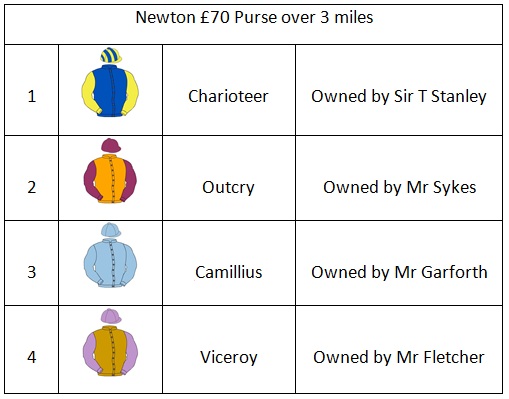
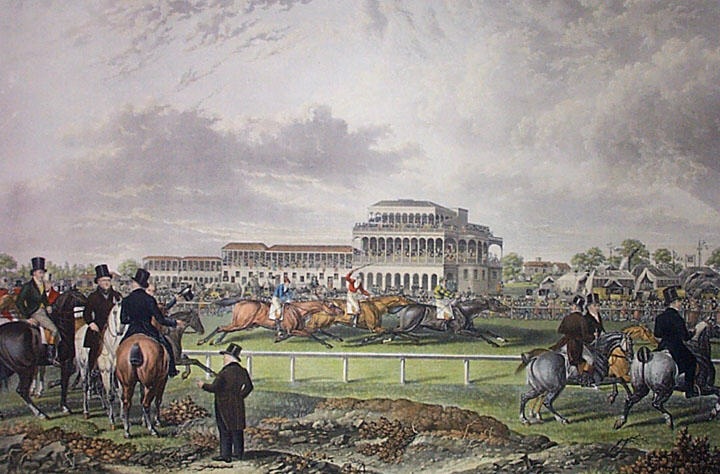
The picture shown above, which was on display in Lyme House, is of a race which took place at Newton Le Willows on Wednesday 1st June 1831 when Fylde beat Halston with Recovery less than a length back in third. The race, value 100 sovereigns, was for The Lord Of the Manor's Gold Cup run over 2 miles and a distance and for a stake worth about £260. The full result was:-
Fylde, an aged bay horse by Antonio, owned by Mr.Clifton and ridden by Whitehouse
Halston, a 6 year old bay horse owned by Mr.Beardsworth
Recovery, a 4 year old chestnut colt, owned by Mr.Turner
Sarah, an aged bay mare owned by Sir J Gerard
Olympus, a 6 year old brown horse owned by Mr Turner
Orthodox, an aged brown gelding owned by Mr Thompson
Lilla, a 4 year old bay filly owned by General Yates
Portia, a 4 year old bay filly owned by Mr Robinson
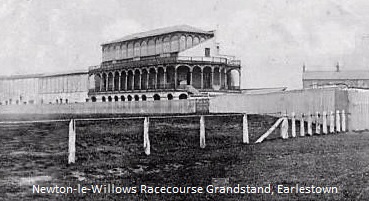
The Sporting Magazine of 1846 comments, “A far more characteristic site for a racecourse than Aintree lies on the line of rail leading from Liverpool to Manchester, known as Newton Moor. The annual races are held on 22nd to 24th of July. It is a most picturesque spot in natural aspect, rural and exceedingly pretty”. The principal races were The Drawing Room Stakes, the Golborn Stakes and the Borough Cup.
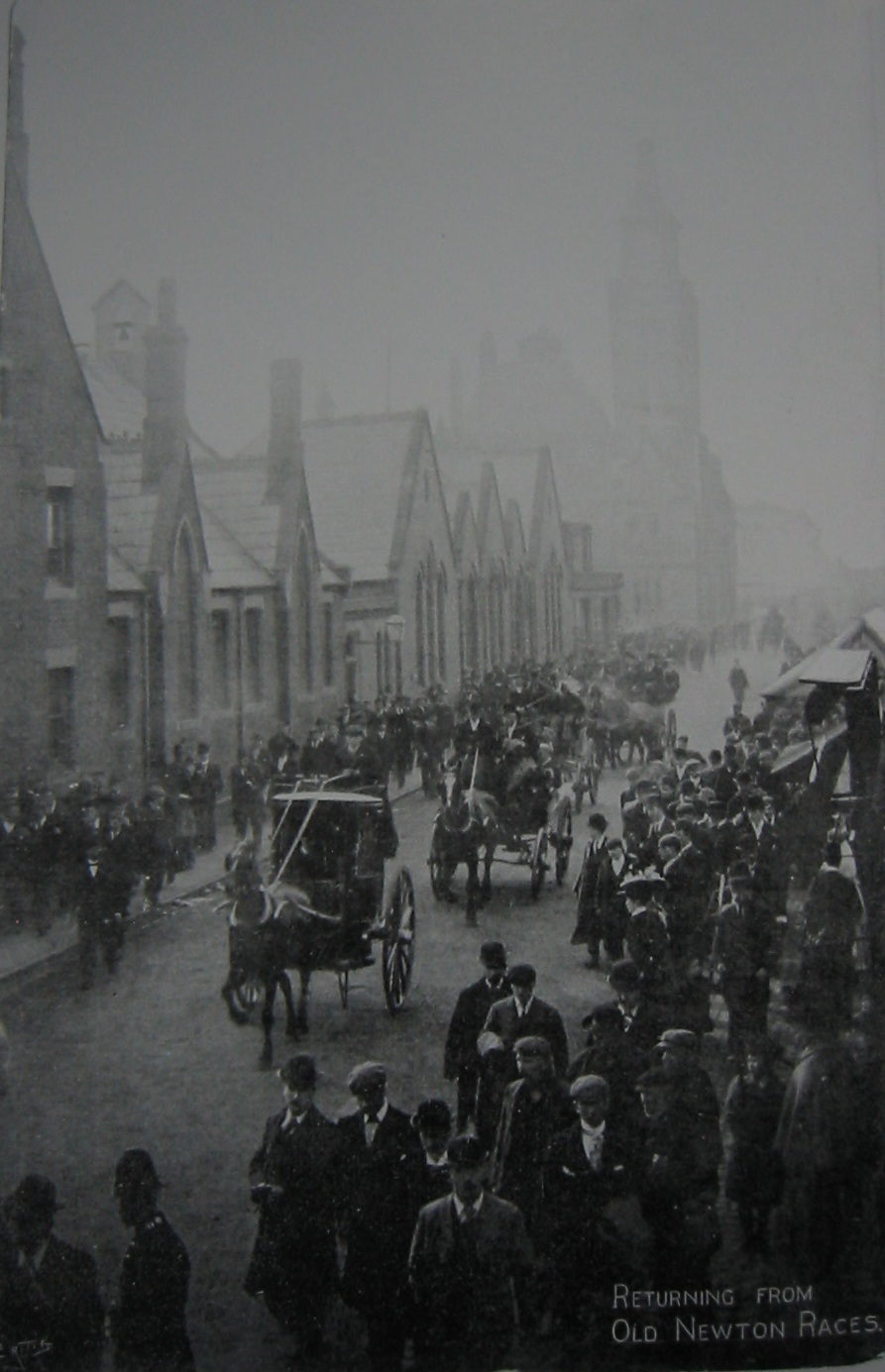
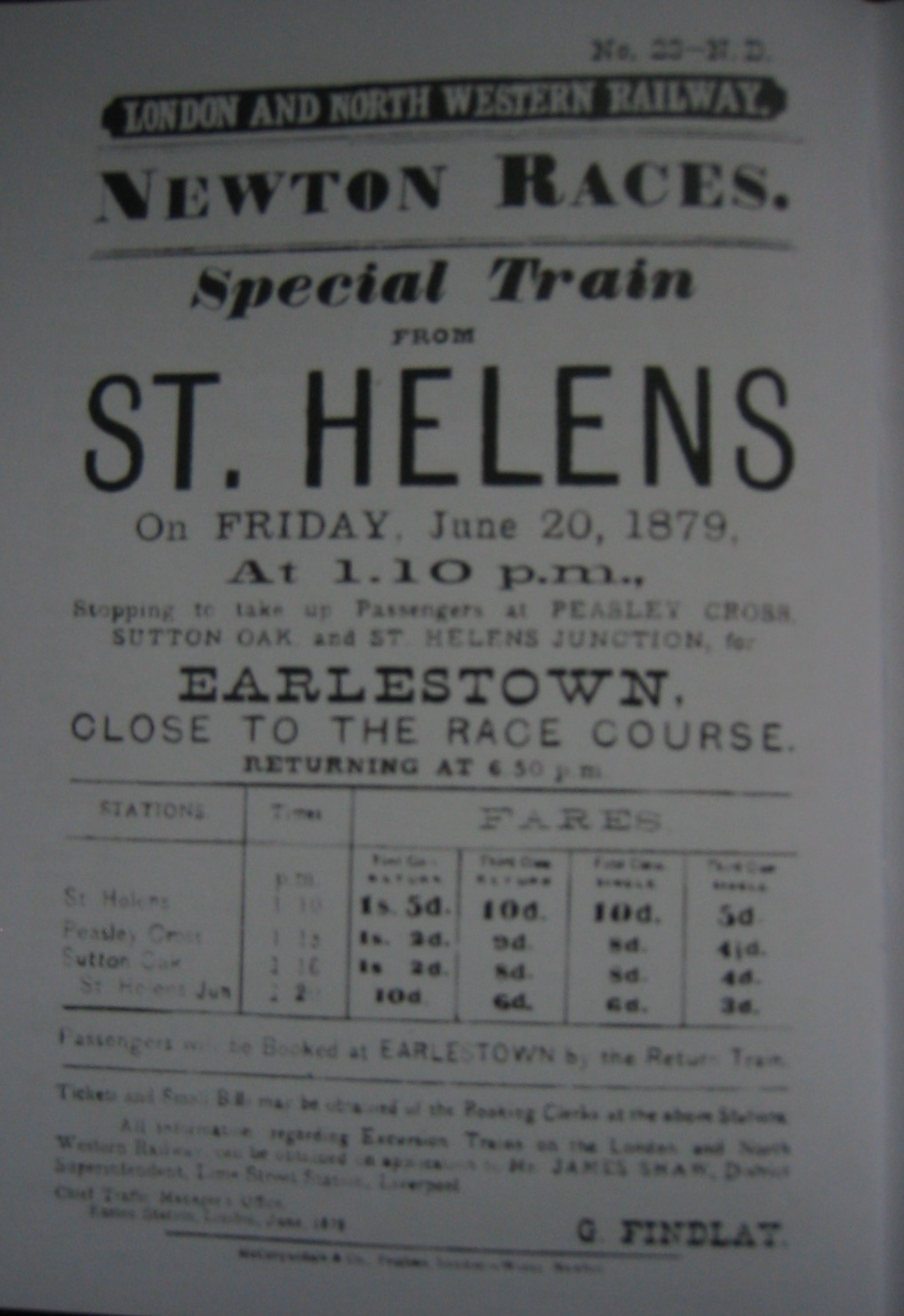
Grateful to Gerald Tinsley for the undated picture of racegoers returning from Old Newton races along Market Street in Earlestown, and for the Advertising poster for trains from St Helens to Newton Races in 1879.
I am grateful to Ordnance Survey (© Crown Copyright) for permission to use the map shown below.
.jpg)
Much of the information about this course has been found using internet research and is in the public domain. However, useful research sources have been:-
London Illustrated News
Racing Illustrated 1895-1899
The Sporting & Dramatic Illustrated
Northern Turf History Volumes 1-4 by J.Fairfax-Blakeborough
The Sporting Magazine
A Long Time Gone by Chris Pitt first published in 1996 ISBN 0 900599 89 8
Racing Calendars which were first published in 1727



